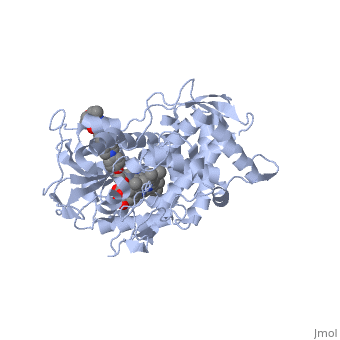User:Madelyn Smith/Sandbox 1
From Proteopedia
|
Contents |
Introduction
Noxafil, also known as Posaconazole, is an antifungal drug used to treat fungal infections caused by Candida and Aspergillus species, as well as treat other fungal infections such as chromoblastomycosis, mycetoma, and coccidioidomycosis. Noxafil is also often used when other antifungal medicines are tolerated or if the patient is immunocompromised. Noxafil is under the triazole class of antifungal drugs and works by inhibiting the production of ergosterol, an important factor in fungi cell membranes, leading to prevention of cell growth and ultimately death.
Structure
- Chemical Formula: C37H42F2N8O4
- Molecular Weight: 700.792 g/mol
- IUPAC name: 4-[4-[4-[4-[[(3R,5R)-5-(2,4-difluorophenyl)-5-(1,2,4-triazol-1-ylmethyl)oxolan-3-yl]methoxy]phenyl]piperazin-1-yl]phenyl]-2-[(2S,3S)-2-hydroxypentan-3-yl]-1,2,4-triazol-3-one
The structure of Posaconazole allows it to potently act as a triazole broad-spectrum antifungal drug that was derived from the antifungal agent, Itraconazole. The differences in structure are that the Chlorine substituents in the aromatic ring on the left-hand side of the images are replaces with Fluorines and that the triazolone sidechain is hydroxylated in the Posaconazole structure[1].
Function
Mechanism
When administered, Posaconazole acts as an antifungal by blocking Lanosterol 14α-demethylase, a P-450 dependant fungal enzyme containing heme as a cofactor. Posaconazole binds to the heme cofactor that the enzyme contains, which prevents the fungus from creating ergosterol, an essential component of the fungal cell membrane. Ergosterol performs in fungal cells how cholesterol does in animal cells, making the cell membrane less permeable. Without it, the cells can no longer proliferate and eventually die because the cell membranes become “leaky”, releasing essential organic components from the cell’s interior and preventing it from performing normal cellular functions. In this way, Posaconazole acts both as fungicidal and fungistatic.
Relevance
Invasive fungal infections, like Candida, Aspergillus, coccidiomycosis, affect patients that are immunocompromised more intensely and are relatively more common in immunocompromised patients. Candida is the most common yeast pathogen while Aspergillus is the most common mold pathogen leading to invasive fungal infections. Noxafil oral suspension is the best form of treatment for invasive Candida and Aspergillus infections in patients 13 years and older who are severely immunocompromised. Noxafil is also more effective at preventing invasive fungal infections in immunocompromised patients when compared to other antifungal treatments (fluconazole and itraconazole). Overall, Noxafil displays fewer cases of invasive fungal infections and is also a more affordable treatment for immunocompromised patients.
Pharmacology
References
- ↑ Knox C, Law V, Jewison T, Liu P, Ly S, Frolkis A, Pon A, Banco K, Mak C, Neveu V, Djoumbou Y, Eisner R, Guo AC, Wishart DS. DrugBank 3.0: a comprehensive resource for 'omics' research on drugs. Nucleic Acids Res. 2011 Jan;39(Database issue):D1035-41. doi:, 10.1093/nar/gkq1126. Epub 2010 Nov 8. PMID:21059682 doi:http://dx.doi.org/10.1093/nar/gkq1126
1. Drug Info/Drug Targets: DrugBank 3.0: a comprehensive resource for 'omics' research on drugs. Knox C, Law V, Jewison T, Liu P, Ly S, Frolkis A, Pon A, Banco K, Mak C, Neveu V, Djoumbou Y, Eisner R, Guo AC, Wishart DS. Nucleic Acids Res. 2011 Jan; 39 (Database issue):D1035-41. | PMID: 21059682 2. Nagappan V, Deresinski S: Reviews of anti-infective agents: posaconazole: a broad-spectrum triazole antifungal agent. Clin Infect Dis. 2007 Dec 15;45(12):1610-7. doi: 10.1086/523576. [PubMed:18190324 ]

